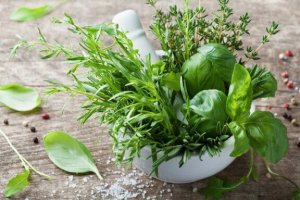The Health Benefits of Tarragon

Tarragon or Artemisia dracunculus L, also known as dragon grass, is a plant with Asian origins. It belongs to the family of Asteraceae plants. It was introduced into Europe in the middle ages and currently grows wild in the south of the continent although it was first introduced in the north.
Tarragon is an ingredient that’s widely used in cooking and it’s appreciated for the unique flavors it provides to stews and sauces. It’s the main ingredient used to prepare Bearnaise sauce.
In addition to being an aromatic herb, tarragon has nutritional and medicinal properties that are very beneficial. It has various vitamins and minerals and it’s also a great antioxidant. Tarragon has digestive properties, helps regulate menstruation and it prevents stomach ulcers.
Nutritional properties of tarragon
Tarragon leaves, (both fresh and dried), contain many vitamins. It contains high concentrations of vitamin C and this makes it a powerful antioxidant.
Tarragon also provides vitamin A and all of the B vitamins: folates, pyridoxine, niacin, riboflavin, etc. These are important active principles which help the nervous system function properly. They are also important for metabolism.
This tasty herb is also rich in minerals. Its leaves are a great source of iron, calcium, magnesium, potassium, phosphorus, zinc and many others. It also contains carbohydrates, fats, proteins, and water.

Tarragon a great ally for your digestive health
Tarragon is associated with multiple healing qualities and health benefits. It’s especially important for the digestive tract. It can be consumed in an infusion after a heavy meal in order to facilitate digestion and to combat gas. Tarragon has also been proven to regulate intestinal transit due to its fiber content.
One of the greatest benefits of tarragon is that it favors the production of bile. This means that digestion is facilitated and toxins are eliminated from the body. It also plays an important function in cleansing the liver and gallbladder and preventing the appearance of stones.
A good way to prepare this aromatic plant is to put its dried leaves in a container with a little apple cider vinegar. Let it rest for seven hours and then have a teaspoon before every meal.
Use it to improve your appetite and to fight intestinal parasites
Tarragon is widely used to induce appetite and to combat anorexia in children. It has also been proven to be effective to relieve hiccups and toothaches.
When it comes to the treatment of toothaches, both the root and the fresh leaves can be used. After being chewed, the plant will act on the affected areas.
In the case of intestinal parasites, tarragon is also a great ally. Prepare an infusion by boiling the leaves in water and then letting the product stand for ten minutes. The preparation should then be filtered and then two cups can be ingested on an empty stomach in the morning, and then two more in the evening before going to sleep.
Other health benefits of tarragon
The consumption of tarragon has many other positive health benefits. One of them is that it helps to lower blood sugar. That’s why it’s highly recommended for people suffering from diabetes.

Tarragon can also be used to heal wounds since it has many antibiotic and antiseptic properties, it’s also an analgesic. It has also been shown to counteract bad breath and due to its sedative properties, it can be used to combat insomnia and nervousness.
Other benefits of tarragon include the fact that it helps prevent stomach ulcers, regulates the menstrual cycle and it also helps relieve menstrual pain.
Finally, it has also been credited with the ability to prevent the activation of platelets. Therefore, it’s useful when it comes to the prevention of blood clots in the arteries of both the heart and the brain.
Tarragon or Artemisia dracunculus L, also known as dragon grass, is a plant with Asian origins. It belongs to the family of Asteraceae plants. It was introduced into Europe in the middle ages and currently grows wild in the south of the continent although it was first introduced in the north.
Tarragon is an ingredient that’s widely used in cooking and it’s appreciated for the unique flavors it provides to stews and sauces. It’s the main ingredient used to prepare Bearnaise sauce.
In addition to being an aromatic herb, tarragon has nutritional and medicinal properties that are very beneficial. It has various vitamins and minerals and it’s also a great antioxidant. Tarragon has digestive properties, helps regulate menstruation and it prevents stomach ulcers.
Nutritional properties of tarragon
Tarragon leaves, (both fresh and dried), contain many vitamins. It contains high concentrations of vitamin C and this makes it a powerful antioxidant.
Tarragon also provides vitamin A and all of the B vitamins: folates, pyridoxine, niacin, riboflavin, etc. These are important active principles which help the nervous system function properly. They are also important for metabolism.
This tasty herb is also rich in minerals. Its leaves are a great source of iron, calcium, magnesium, potassium, phosphorus, zinc and many others. It also contains carbohydrates, fats, proteins, and water.

Tarragon a great ally for your digestive health
Tarragon is associated with multiple healing qualities and health benefits. It’s especially important for the digestive tract. It can be consumed in an infusion after a heavy meal in order to facilitate digestion and to combat gas. Tarragon has also been proven to regulate intestinal transit due to its fiber content.
One of the greatest benefits of tarragon is that it favors the production of bile. This means that digestion is facilitated and toxins are eliminated from the body. It also plays an important function in cleansing the liver and gallbladder and preventing the appearance of stones.
A good way to prepare this aromatic plant is to put its dried leaves in a container with a little apple cider vinegar. Let it rest for seven hours and then have a teaspoon before every meal.
Use it to improve your appetite and to fight intestinal parasites
Tarragon is widely used to induce appetite and to combat anorexia in children. It has also been proven to be effective to relieve hiccups and toothaches.
When it comes to the treatment of toothaches, both the root and the fresh leaves can be used. After being chewed, the plant will act on the affected areas.
In the case of intestinal parasites, tarragon is also a great ally. Prepare an infusion by boiling the leaves in water and then letting the product stand for ten minutes. The preparation should then be filtered and then two cups can be ingested on an empty stomach in the morning, and then two more in the evening before going to sleep.
Other health benefits of tarragon
The consumption of tarragon has many other positive health benefits. One of them is that it helps to lower blood sugar. That’s why it’s highly recommended for people suffering from diabetes.

Tarragon can also be used to heal wounds since it has many antibiotic and antiseptic properties, it’s also an analgesic. It has also been shown to counteract bad breath and due to its sedative properties, it can be used to combat insomnia and nervousness.
Other benefits of tarragon include the fact that it helps prevent stomach ulcers, regulates the menstrual cycle and it also helps relieve menstrual pain.
Finally, it has also been credited with the ability to prevent the activation of platelets. Therefore, it’s useful when it comes to the prevention of blood clots in the arteries of both the heart and the brain.
All cited sources were thoroughly reviewed by our team to ensure their quality, reliability, currency, and validity. The bibliography of this article was considered reliable and of academic or scientific accuracy.
- Plantas aromáticas. Diputación de Valencia. 2014. Extraído de: https://www.dival.es/sites/default/files/medio-ambiente/Estudio3.pdf
- Fretes, Francisco. Plantas aromáticas. Extraído de: https://www.usaid.gov/sites/default/files/documents/1862/plantas_medicinales.pdf
This text is provided for informational purposes only and does not replace consultation with a professional. If in doubt, consult your specialist.








